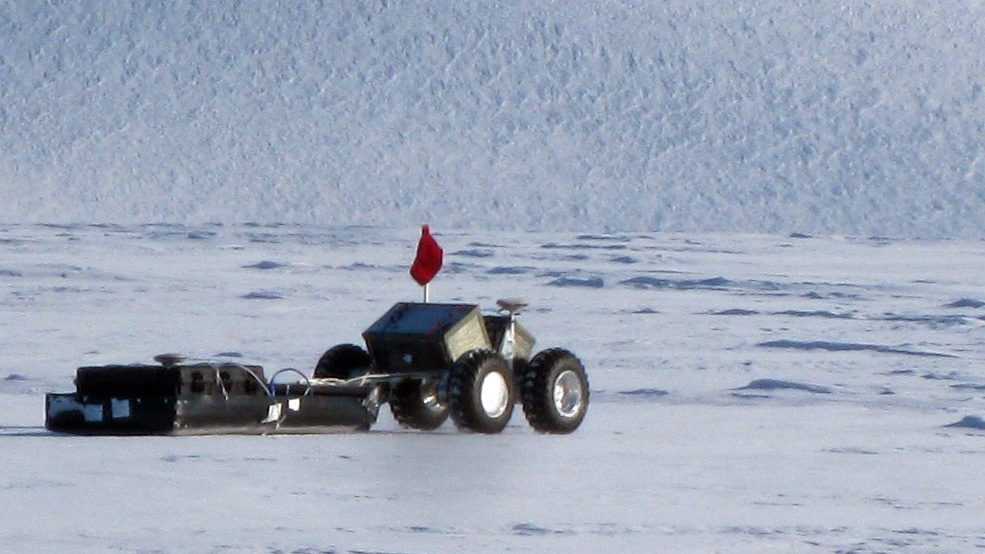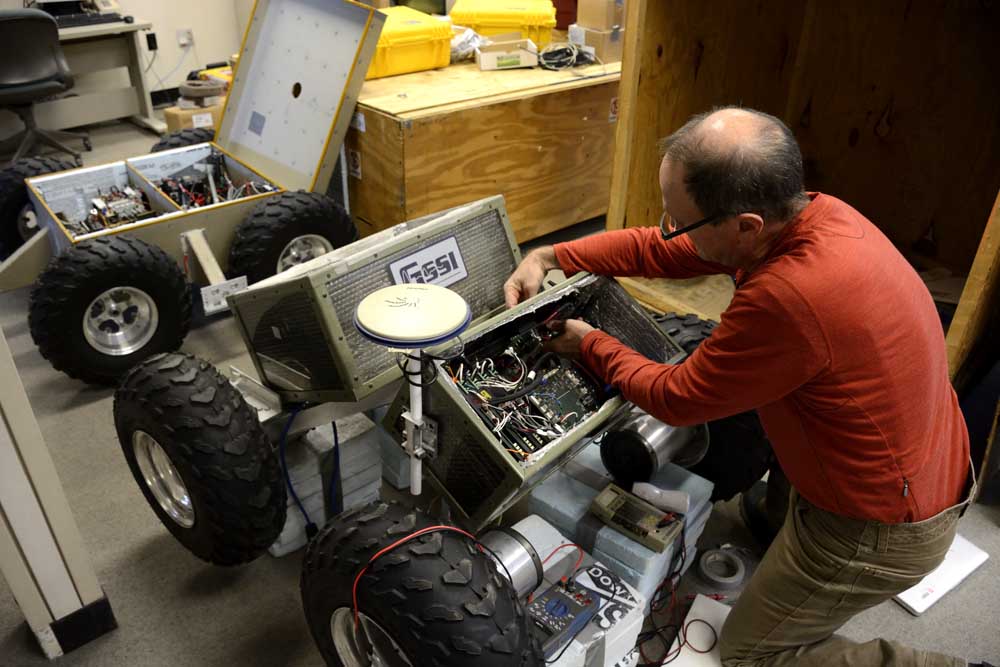Rough terrainRobots to help map crevasse-riddled area crucial to stability of Ross Ice ShelfPosted October 23, 2014
Glaciologists often describe an ice shelf as a cork in a bottle, keeping the glaciers that feed into it bottled up. Pop the cork – disintegrate the ice shelf – and all that ice starts to flow quicker, eventually contributing to sea-level rise. The Ross Ice Shelf, the world’s largest floating slab of ice at 472,000 square kilometers (roughly the size of Spain), serves as a bulwark for numerous glaciers and ice streams that could potentially drain enough of Antarctica’s ice sheets to raise global sea level between four and five meters. Helping stabilize the Ross Ice Shelf is an area known as the shear margin or shear zone, a small strip of heavily crevassed ice that abuts the much smaller McMurdo Ice Shelf. The weird dynamics of the shear zone, pinched between the two ice shelves, has a team of researchers concerned that its potential instability could have long-term repercussions for the Ross Ice Shelf. “If you take [the shear zone] away, the Ross Ice Shelf would slowly start to disintegrate farther south,” said Gordon Hamilton, an associate professor at the University of Maine’s Climate Change Institute. Hamilton is the principal investigator (PI) on a three-year field project to study and map the shear zone’s surface flow field using GPS observations and its buried crevasses using small, rover-like robots sporting ground-penetrating radar (GPR). Crevasses are deep cracks that form in the glacial ice. They are so prominent and numerous in the shear zone as to be seen from satellites in orbit. The shear zone is particularly unique because of the nature of the crevasse field, according to Hamilton. “This is one of the few places in the world where you have observations of the crevasse fields below the surface,” he said during an interview at McMurdo Station’s Crary Science and Engineering Center before he and his four team members spend the next three weeks at the shear zone, located about 40 kilometers away. Hamilton explained that the subsurface crevasses don’t appear to match up against what’s visible at the surface, suggesting some odd flow patterns that could indicate that the shear zone is unstable. “The shapes of the crevasses are not what you would expect with a simple model of a stable ice shelf shear margin,” he said. Jim Lever, a mechanical engineer with the U.S. Army Cold Regions Research and Engineering Laboratory (CRREL), has descended – intentionally – into a few crevasses in this lifetime. “They’re complicated structures,” he said. NSF-funded research Lever holds an adjunct position at Dartmouth College, which has developed a pair of four-wheeled robots that are designed to operate in the polar environment under co-PI Laura Ray, a professor of engineering at the school’s Thayer School of Engineering. Lever was assembling both machines in the Crary Lab in preparation for their use in the field. The Cool Robot sports a square, lightweight chassis built from the same honeycombed material used for airplanes. It runs on solar power, though it has been outfitted with batteries for the shear zone mission this year. Its companion, Yeti, weighs in at about 70 kilograms, with an articulating A-frame-looking body. The former robot was originally designed for long-duration science missions while the latter was built specifically to support operations that required a crevasse-detection tool, especially in areas that could be too dangerous for humans with heavier equipment. This is the first time the two machines have worked in tandem, according to Lever. “The robot can do over and back surveys safely,” noted Lever of the shear zone project. 
Photo Courtesy: Gordon Hamilton
Gordon Hamilton conducts fieldwork on the Helheim Glacier in Greenland during a previous season.
The shear zone also happens to be at the starting line for the South Pole Traverse, a tractor train used to haul mainly fuel 1,600 kilometers between McMurdo and South Pole stations. Heavy equipment operators pull nearly frictionless sleds holding bladders of fuel using large Case and Caterpillar tractors. A reconnaissance trip to the shear zone by traverse crew members a few weeks ago identified at least three crevasse features that needed to be remediated before the journey to South Pole begins, according to traverse coordinator Rick Campbell. “It’s different every year,” he said. “The shear zone is doing weird things.” A tracked vehicle called a Pisten Bully carries its own GPR unit on a long boom extended out in front of the vehicle, leading the line of tractors safely along the traverse route. Yeti and Cool Robot will greatly expand the radar dataset on the shear zone from the narrow corridor traveled by the tractors to a 50-square-kilometer grid. 
Photo Credit: Tim Thomas/Antarctic Photo Library
A South Pole Traverse tractor fills in a crevasse with snow.
Hamilton said the comprehensive survey might find sections of the shear zone that could offer a safer route – or discover that the crevasse-riddled ice may become unpassable in the future. Campbell noted that the only viable route from McMurdo to South Pole has to cross the five-kilometer-wide crevasse field. The traverse is set to make three swings to South Pole this year for the first time ever, delivering more than 300,000 gallons of fuel, saving millions of dollars over flying fuel by LC-130 aircraft. “If the shear margin is unstable and crevasses start to form in unpredictable ways, the long-term viability of the traverse crossing becomes harder to manage,” Hamilton noted. The next three years should help the researchers better understand the likelihood of that scenario. The Yeti and Cool Robot rovers will provide enough data to help the team create a three-dimensional model that can replicate the behavior of the ice and predict possible changes in the future. 
Photo Credit: Jim Lever
CRREL engineer Zoe Courville prepares Yeti for work in the shear zone in 2010. In the distance is the Pisten Bully with the ground-penetrating radar.
On a broader perspective, the long-term viability of the Ross Ice Shelf could be affected. Ice streams from West Antarctica and mountain glaciers from East Antarctica could double or even triple their flow rates if the ice shelf begins to break apart. Byrd Glacier alone drains an area of East Antarctica almost equal to the size of all of West Antarctica, according to Hamilton. “If you double its flow speed, you’re going to suck ice out of East Antarctica very quickly,” he said. Hamilton is glad to have the robots not only for their ability to take continuous data for better modeling of ice dynamics, but also for increased safety and operational efficiency. A project he worked on 15 years ago required entering a similarly crevassed shear margin on an ice stream in West Antarctica. “It was nerve-wracking. You’re never sure when these snow bridges are going to give way,” he said. “It was a great project to do, but I would never do something like it again. … This project is essentially the same, but the robots are doing all the heavy lifting for us. “The places that really control the future of the ice sheet are hard-to-access places, like shear margins or the underside of the ice shelf or the middle of crevassed outlet glaciers,” he added. “It’s hard to get good datasets there.” Not for much longer. Send in the robots. |



For USAP Participants |
For The Public |
For Researchers and EducatorsContact UsNational Science FoundationOffice of Polar Programs Geosciences Directorate 2415 Eisenhower Avenue, Suite W7100 Alexandria, VA 22314 Sign up for the NSF Office of Polar Programs newsletter and events. Feedback Form |




